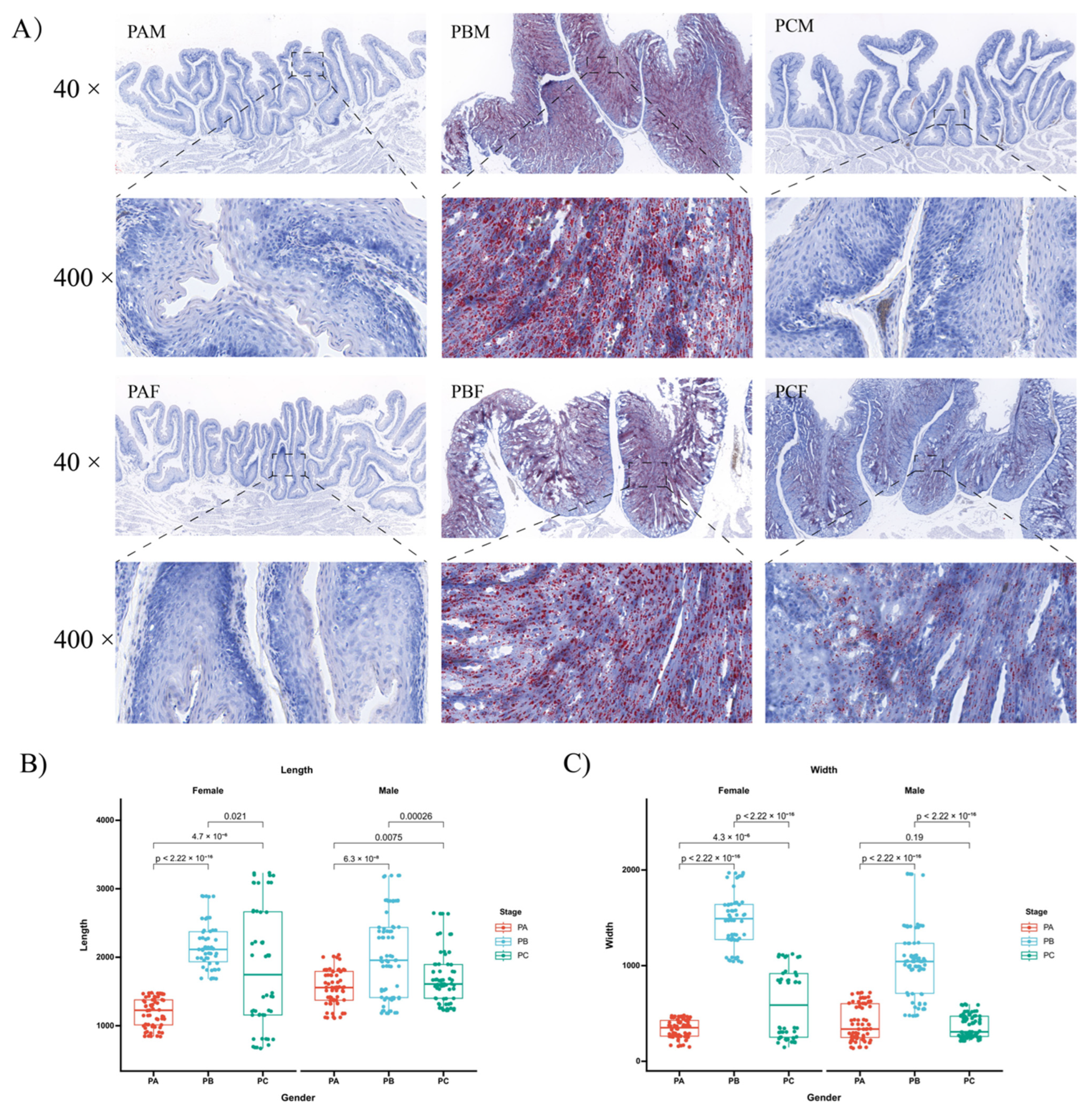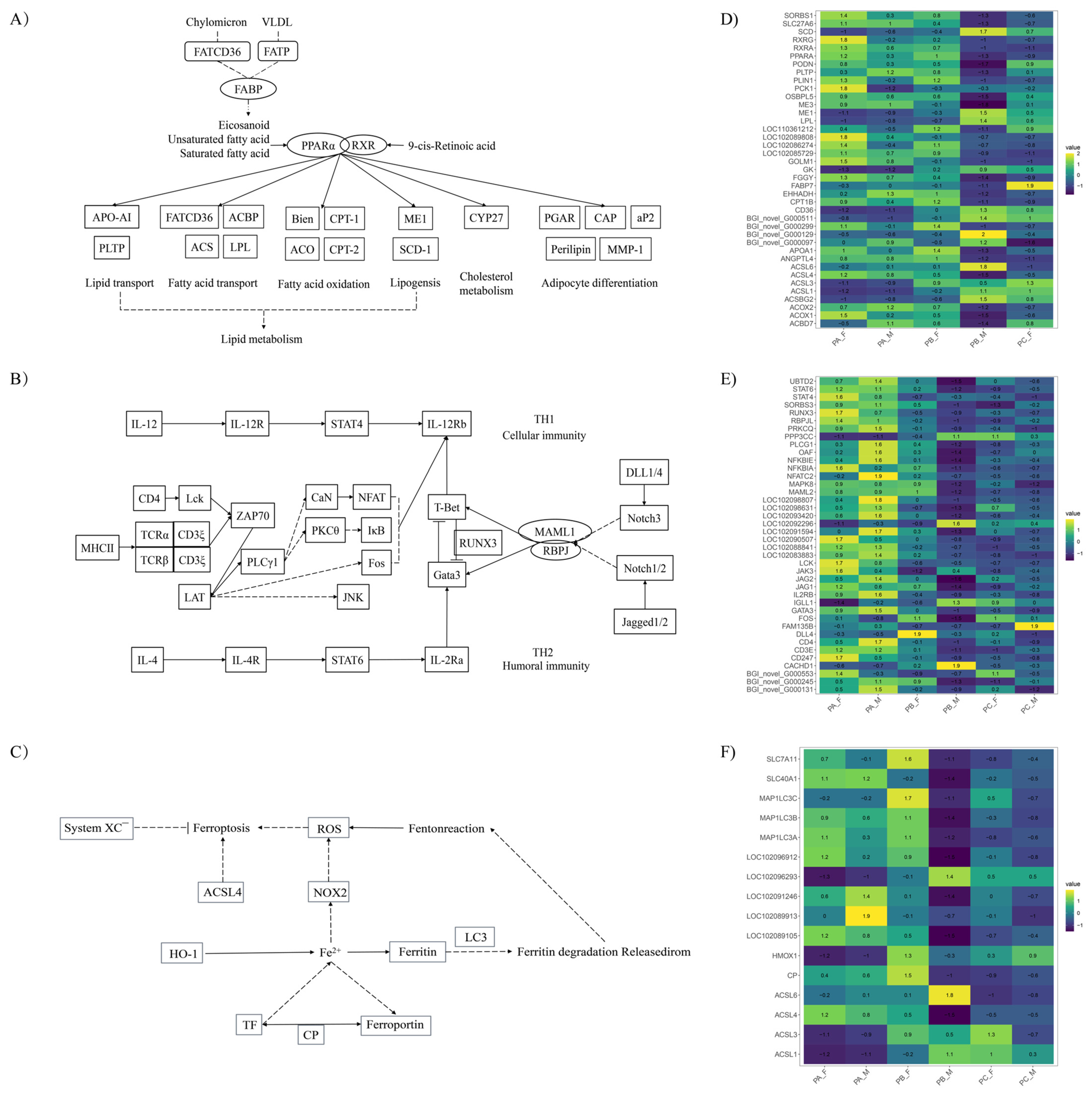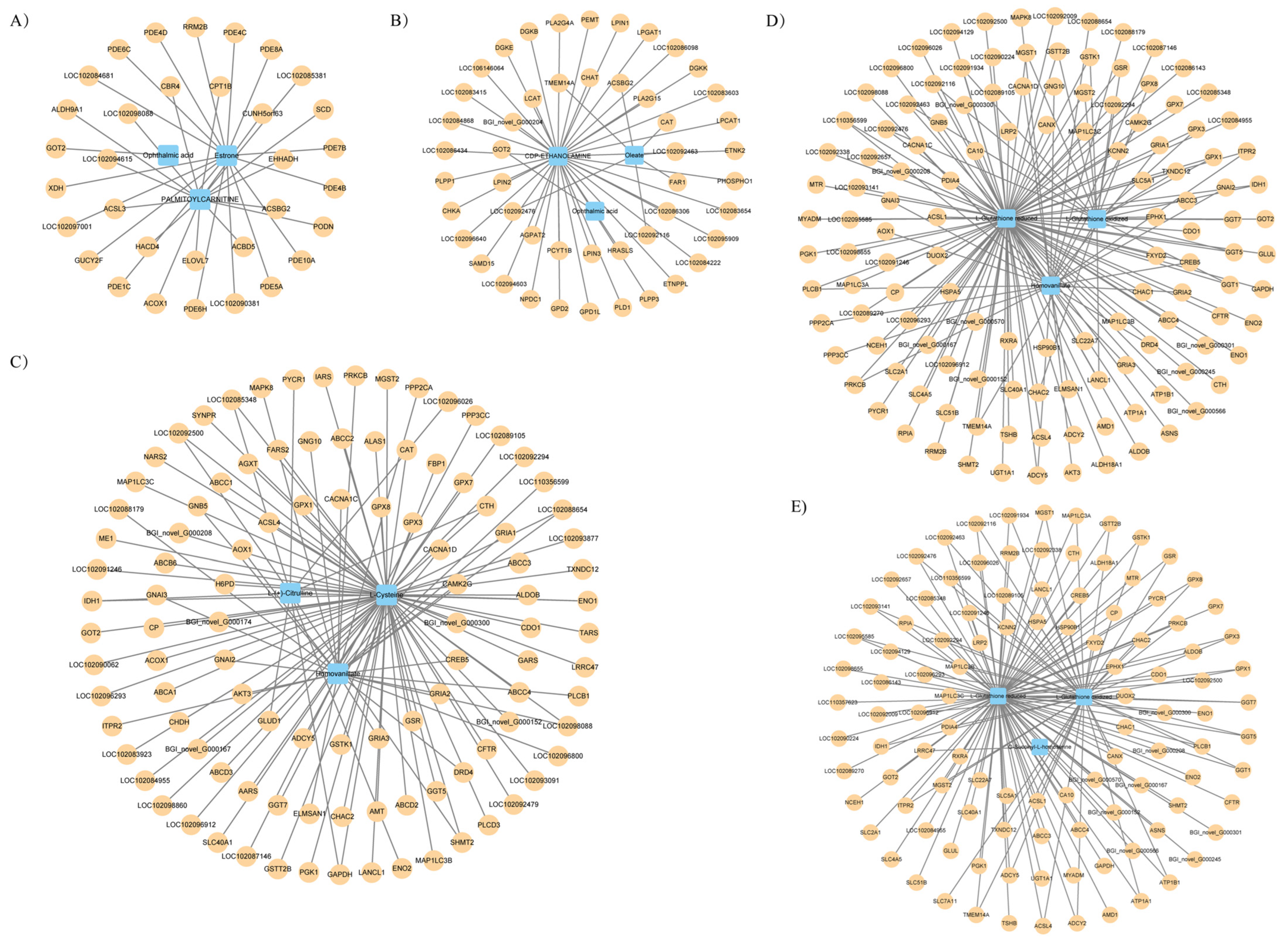Comprehensive Transcriptomic and Metabolomic Analysis Revealed the Functional Differences in Pigeon Lactation between Male and Female during the Reproductive Cycle
Abstract
:Simple Summary
Abstract
1. Background
2. Material and Methods
2.1. Sample Collection
2.2. Morphological Changes and Histology of Crop Tissue
2.3. RNA-Seq Process
2.4. Metabolite Detection and Data Analysis
2.5. qRT-PCR Qualification
2.6. Statistical Analysis
3. Results
3.1. Morphological and Structural Changes in the Crop of Male and Female Pigeons across Different Breeding Cycles
3.2. Metabolite Analysis Showed Differential Metabolite Accumulation during Breeding Cycles
3.3. Transcriptome Analysis Reveals the Differentially Expressed Genes during the Breeding Cycles
3.4. Functional Gene Involvement in Lactation
3.5. Combined Analysis of Metabolome and Transcriptome in Parent Pigeons
3.6. Gender-Specific Differences in the Metabolome and Gene Expression of Crop Tissues
3.7. Validation of Candidate DEGs by Quantitative Real-Time PCR
4. Discussion
5. Conclusions
Supplementary Materials
Author Contributions
Funding
Institutional Review Board Statement
Informed Consent Statement
Data Availability Statement
Acknowledgments
Conflicts of Interest
References
- Shetty, S.; Bharathi, L.; Shenoy, K.B.; Hegde, S.N. Biochemical properties of pigeon milk and its effect on growth. J. Comp. Physiol. B 1992, 162, 632–636. [Google Scholar] [CrossRef]
- Beason, R.C.; Wiltschko, W. Cues indicating location in pigeon navigation. J. Comp. Physiol. A 2015, 201, 961–967. [Google Scholar] [CrossRef] [PubMed]
- Kozák, G.; Janiga, M.; Solár, J. Pollution of Feral Pigeon (Columba livia) Depends on Their Age and Their Health Status. Biol. Trace Elem. Res. 2022, 200, 790–799. [Google Scholar] [CrossRef] [PubMed]
- Maclary, E.T.; Phillips, B.; Wauer, R.; Boer, E.F.; Bruders, R.; Gilvarry, T.; Holt, C.; Yandell, M.; Shapiro, M.D. Two Genomic Loci Control Three Eye Colors in the Domestic Pigeon (Columba livia). Mol. Biol. Evol. 2021, 38, 5376–5390. [Google Scholar] [CrossRef] [PubMed]
- Anderson, J.L.; Smith, S.C.; Taylor, R.L., Jr. The pigeon (Columba livia) model of spontaneous atherosclerosis. Poult. Sci. 2014, 93, 2691–2699. [Google Scholar] [CrossRef] [PubMed]
- Dong, X.Y.; Zhang, M.; Jia, Y.X.; Zou, X.T. Physiological and hormonal aspects in female domestic pigeons (Columba livia) associated with breeding stage and experience. J. Anim. Physiol. Anim. Nutr. 2013, 97, 861–867. [Google Scholar] [CrossRef] [PubMed]
- Xie, P.; Wan, X.P.; Bu, Z.; Diao, E.J.; Gong, D.Q.; Zou, X.T. Changes in hormone profiles, growth factors, and mRNA expression of the related receptors in crop tissue, relative organ weight, and serum biochemical parameters in the domestic pigeon (Columba livia) during incubation and chick-rearing periods under artificial farming conditions. Poult. Sci. 2018, 97, 2189–2202. [Google Scholar] [CrossRef] [PubMed]
- Farrar, V.S.; Harris, R.M.; Austin, S.H.; Nava Ultreras, B.M.; Booth, A.M.; Angelier, F.; Lang, A.S.; Feustel, T.; Lee, C.; Bond, A.; et al. Prolactin and prolactin receptor expression in the HPG axis and crop during parental care in both sexes of a biparental bird (Columba livia). Gen. Comp. Endocrinol. 2022, 315, 113940. [Google Scholar] [CrossRef]
- Sales, J.; Janssens, G.P.J. Nutrition of the domestic pigeon (Columba livia domestica). World’s Poult. Sci. J. 2003, 59, 221–232. [Google Scholar] [CrossRef]
- Horn, P.; Meleg, I. Inbreeding effects on production traits in pigeons. Arch. Fur Geflugelkd. 2000, 64, 273–277. [Google Scholar]
- Horseman, N.D.; Buntin, J.D. Regulation of pigeon cropmilk secretion and parental behaviors by prolactin. Annu. Rev. Nutr. 1995, 15, 213–238. [Google Scholar] [CrossRef] [PubMed]
- Davies, W.L. The composition of the crop milk of pigeons. Biochem. J. 1939, 33, 898–901. [Google Scholar] [CrossRef] [PubMed]
- Gao, C.Q.; Yang, J.X.; Chen, M.X.; Yan, H.C.; Wang, X.Q. Growth curves and age-related changes in carcass characteristics, organs, serum parameters, and intestinal transporter gene expression in domestic pigeon (Columba livia). Poult. Sci. 2016, 95, 867–877. [Google Scholar] [CrossRef] [PubMed]
- Gillespie, M.J.; Crowley, T.M.; Haring, V.R.; Wilson, S.L.; Harper, J.A.; Payne, J.S.; Green, D.; Monaghan, P.; Stanley, D.; Donald, J.A.; et al. Transcriptome analysis of pigeon milk production—Role of cornification and triglyceride synthesis genes. BMC Genom. 2013, 14, 169. [Google Scholar] [CrossRef] [PubMed]
- Vandeputte-Poma, J. Feeding, growth and metabolism of the pigeon, Columba livia domestica: Duration and role of crop milk feeding. J. Comp. Physiol. 1980, 135, 97–99. [Google Scholar] [CrossRef]
- Shetty, S.; Sridhar, K.R.; Shenoy, K.B.; Hedge, S.N. Observations on bacteria associated with pigeon crop. Folia Microbiol. 1990, 35, 240–244. [Google Scholar] [CrossRef] [PubMed]
- Goudswaard, J.; van der Donk, J.A.; van der Gaag, I.; Noordzij, A. Peculiar IgA transfer in the pigeon from mother to squab. Dev. Comp. Immunol. 1979, 3, 307–319. [Google Scholar] [CrossRef] [PubMed]
- Gillespie, M.J.; Stanley, D.; Chen, H.; Donald, J.A.; Nicholas, K.R.; Moore, R.J.; Crowley, T.M. Functional similarities between pigeon ‘milk’ and mammalian milk: Induction of immune gene expression and modification of the microbiota. PLoS ONE 2012, 7, e48363. [Google Scholar] [CrossRef]
- Peng, J.; Huang, W.; Yang, M.; Gao, H.; Lv, Y.; Gou, Z.; Wang, Z.; Wang, W.; Huang, Y. Characteristics of glucolipid metabolism and oxidative stress in breeding pigeons (Columba livia) during lactation. J. Anim. Physiol. Anim. Nutr. 2023. ahead of print. [Google Scholar] [CrossRef]
- Xie, P.; Wang, X.P.; Bu, Z.; Zou, X.T. Differential expression of fatty acid transporters and fatty acid synthesis-related genes in crop tissues of male and female pigeons (Columba livia domestica) during incubation and chick rearing. Br. Poult. Sci. 2017, 58, 594–602. [Google Scholar] [CrossRef]
- Ma, H.; Ge, P.; Bian, S.; Li, Y.; Ni, A.; Zhang, R.; Wang, Y.; Zhao, J.; Zong, Y.; Yuan, J.; et al. miR-193-5p negatively regulates PIK3CD to promote crop fibrocyte proliferation in pigeon (Columba livia). Poult. Sci. 2023, 102, 102378. [Google Scholar] [CrossRef] [PubMed]
- Chen, M.J.; Fu, Z.; Jiang, S.G.; Wang, X.Q.; Yan, H.C.; Gao, C.Q. Targeted disruption of TORC1 retards young squab growth by inhibiting the synthesis of crop milk protein in breeding pigeon (Columba livia). Poult. Sci. 2020, 99, 416–422. [Google Scholar] [CrossRef] [PubMed]
- Ma, H.; Ni, A.; Ge, P.; Li, Y.; Shi, L.; Wang, P.; Fan, J.; Isa, A.M.; Sun, Y.; Chen, J. Analysis of Long Non-Coding RNAs and mRNAs Associated with Lactation in the Crop of Pigeons (Columba livia). Genes 2020, 11, 201. [Google Scholar] [CrossRef] [PubMed]
- Wang, L.; Zhu, J.; Xie, P.; Gong, D. Pigeon during the Breeding Cycle: Behaviors, Composition and Formation of Crop Milk, and Physiological Adaptation. Life 2023, 13, 1866. [Google Scholar] [CrossRef] [PubMed]
- Wang, Y.; Wang, X.; Luo, Y.; Zhang, J.; Lin, Y.; Wu, J.; Zeng, B.; Liu, L.; Yan, P.; Liang, J.; et al. Spatio-temporal transcriptome dynamics coordinate rapid transition of core crop functions in ‘lactating’ pigeon. PLoS Genet. 2023, 19, e1010746. [Google Scholar] [CrossRef] [PubMed]
- Dumont, J.N. Prolactin-induced cytologic changes in the mucosa of the pigeon crop during crop-“milk” formation. Z. Fur Zellforsch. Mikrosk. Anat. 1965, 68, 755–782. [Google Scholar] [CrossRef]
- Gillespie, M.J.; Haring, V.R.; McColl, K.A.; Monaghan, P.; Donald, J.A.; Nicholas, K.R.; Moore, R.J.; Crowley, T.M. Histological and global gene expression analysis of the ‘lactating’ pigeon crop. BMC Genom. 2011, 12, 452. [Google Scholar] [CrossRef]
- Yang, M.C.; Vohra, P. Protein and metabolizable energy requirements of hand-fed squabs from hatching to 28 days of age. Poult. Sci. 1987, 66, 2017–2023. [Google Scholar] [CrossRef]
- Shetty, S.; Hegde, S.N. Changes in lipids of pigeon “milk” in the first week of its secretion. Lipids 1991, 26, 930–933. [Google Scholar] [CrossRef]
- Sun, B.; Fujiwara, K.; Adachi, S.; Inoue, K. Physiological roles of prolactin-releasing peptide. Regul. Pept. 2005, 126, 27–33. [Google Scholar] [CrossRef]
- Tontonoz, P.; Spiegelman, B.M. Fat and Beyond: The Diverse Biology of PPARγ. Annu. Rev. Biochem. 2008, 77, 289–312. [Google Scholar] [CrossRef] [PubMed]
- Monsalve, F.A.; Pyarasani, R.D.; Delgado-Lopez, F.; Moore-Carrasco, R. Peroxisome Proliferator-Activated Receptor Targets for the Treatment of Metabolic Diseases. Mediat. Inflamm. 2013, 2013, 549627. [Google Scholar] [CrossRef] [PubMed]
- Kersten, S.; Desvergne, B.; Wahli, W. Roles of PPARs in health and disease. Nature 2000, 405, 421–424. [Google Scholar] [CrossRef] [PubMed]
- Bougarne, N.; Weyers, B.; Desmet, S.J.; Deckers, J.; Ray, D.W.; Staels, B.; De Bosscher, K. Molecular Actions of PPARα in Lipid Metabolism and Inflammation. Endocr. Rev. 2018, 39, 760–802. [Google Scholar] [CrossRef] [PubMed]
- Xie, P.; Zhang, A.T.; Wang, C.; Azzam, M.M.M.; Zou, X.T. Molecular cloning, characterization, and expression analysis of fatty acid translocase (FAT/CD36) in the pigeon (Columba livia domestica). Poult. Sci. 2012, 91, 1670–1679. [Google Scholar] [CrossRef] [PubMed]
- Van de Perre, P. Transfer of antibody via mother’s milk. Vaccine 2003, 21, 3374–3376. [Google Scholar] [CrossRef] [PubMed]
- Engberg, R.M.; Kaspers, B.; Schranner, I.; Kösters, J.; Lösch, U. Quantification of the immunoglobulin classes IgG and IgA in the young and adult pigeon (Columba livia). Avian Pathol. 1992, 21, 409–420. [Google Scholar] [CrossRef] [PubMed]
- Mosmann, T.R.; Cherwinski, H.; Bond, M.W.; Giedlin, M.A.; Coffman, R.L. Two types of murine helper T cell clone. I. Definition according to profiles of lymphokine activities and secreted proteins. J. Immunol. 1986, 136, 2348–2357. [Google Scholar] [CrossRef]
- Lee, G.R. Molecular Mechanisms of T Helper Cell Differentiation and Functional Specialization. Immune Netw. 2023, 23, e4. [Google Scholar] [CrossRef]
- Kanhere, A.; Hertweck, A.; Bhatia, U.; Gökmen, M.R.; Perucha, E.; Jackson, I.; Lord, G.M.; Jenner, R.G. T-bet and GATA3 orchestrate Th1 and Th2 differentiation through lineage-specific targeting of distal regulatory elements. Nat. Commun. 2012, 3, 1268. [Google Scholar] [CrossRef]
- Flohé, L.; Toppo, S.; Cozza, G.; Ursini, F. A Comparison of Thiol Peroxidase Mechanisms. Antioxid. Redox Signal. 2011, 15, 763–780. [Google Scholar] [CrossRef] [PubMed]
- Jiang, X.; Stockwell, B.R.; Conrad, M. Ferroptosis: Mechanisms, biology and role in disease. Nat. Rev. Mol. Cell Biol. 2021, 22, 266–282. [Google Scholar] [CrossRef] [PubMed]
- Doll, S.; Proneth, B.; Tyurina, Y.Y.; Panzilius, E.; Kobayashi, S.; Ingold, I.; Irmler, M.; Beckers, J.; Aichler, M.; Walch, A.; et al. ACSL4 dictates ferroptosis sensitivity by shaping cellular lipid composition. Nat. Chem. Biol. 2016, 13, 91–98. [Google Scholar] [CrossRef] [PubMed]
- Brown, C.W.; Amante, J.J.; Goel, H.L.; Mercurio, A.M. The α6β4 integrin promotes resistance to ferroptosis. J. Cell Biol. 2017, 216, 4287–4297. [Google Scholar] [CrossRef] [PubMed]
- Wu, J.; Minikes, A.M.; Gao, M.; Bian, H.; Li, Y.; Stockwell, B.R.; Chen, Z.-N.; Jiang, X. Intercellular interaction dictates cancer cell ferroptosis via NF2–YAP signalling. Nature 2019, 572, 402–406. [Google Scholar] [CrossRef] [PubMed]
- Li, Y.; Feng, D.; Wang, Z.; Zhao, Y.; Sun, R.; Tian, D.; Liu, D.; Zhang, F.; Ning, S.; Yao, J.; et al. Ischemia-induced ACSL4 activation contributes to ferroptosis-mediated tissue injury in intestinal ischemia/reperfusion. Cell Death Differ. 2019, 26, 2284–2299. [Google Scholar] [CrossRef]
- Xie, P.; Han, M.X.; Chen, W.X.; Wan, X.P.; Xu, Y.G.; Gong, D.Q. The profiling of amino acids in crop milk and plasma and mRNA abundance of amino acid transporters and enzymes related to amino acid synthesis in the crop tissue of male and female pigeons during incubation and chick-rearing periods. Poult. Sci. 2020, 99, 1628–1642. [Google Scholar] [CrossRef]
- Bharathi, L.; Shenoy, K.B.; Hegde, S.N. Biochemical Differences between Crop Tissue and Crop Milk of Pigeons (Columba livia). Comp. Biochem. Physiol. Part A Physiol. 1997, 116, 51–55. [Google Scholar] [CrossRef]
- Perricone, C.; De Carolis, C.; Perricone, R. Glutathione: A key player in autoimmunity. Autoimmun. Rev. 2009, 8, 697–701. [Google Scholar] [CrossRef]
- Kwon, D.H.; Lee, H.; Park, C.; Hong, S.H.; Hong, S.H.; Kim, G.Y.; Cha, H.J.; Kim, S.; Kim, H.S.; Hwang, H.J.; et al. Glutathione Induced Immune-Stimulatory Activity by Promoting M1-Like Macrophages Polarization via Potential ROS Scavenging Capacity. Antioxidants 2019, 8, 413. [Google Scholar] [CrossRef]




| Comparison | Name | Fold Change | p-Value | Molecular Weight |
|---|---|---|---|---|
| PAM vs. PAF | Glyceraldehyde 3-phosphate | 7.04 | 0.02 | 169.99835 |
| N-Acetyl-L-glutamic acid | 0.12 | 0.02 | 189.064 | |
| Homovanillate | 0.10 | 0.03 | 204.04016 | |
| 1-Arachidoyl-sn-glycero-3-phosphate | 0.04 | 0.04 | 466.30605 | |
| Gamma-glutamyl-gamma-glutamyl-S-methylcysteine | 0.03 | 0.04 | 393.12053 | |
| PBM vs. PBF | 5′-S-Methyl-5′-thioinosine | 20.95 | 0.01 | 298.07362 |
| L-Cystine | 19.16 | 0.03 | 240.02379 | |
| Carnosine | 0.10 | 0.03 | 226.10663 | |
| Sedoheptulose 1,7-bisphosphate | 0.09 | 0.03 | 370.00547 | |
| Reduced glutathione | 0.04 | 0.04 | 307.08385 | |
| PCM vs. PCF | 3β-Androstanediol | 7.66 | 0.00 | 292.24022 |
| Spermidine | 5.18 | 0.02 | 145.15816 | |
| Dehydrosiphonochalynol | 0.56 | 0.03 | 302.16639 | |
| L-cystathionine | 0.38 | 0.04 | 222.0674 | |
| Cystathionine | 0.23 | 0.01 | 222.06738 |
| Comparison | Kegg_Term | Enrich_Ratio | p-Value | q-Value |
|---|---|---|---|---|
| PAF vs. PAM | Viral protein interaction with cytokine and cytokine receptor | 1.88 × 10−1 | 3.14 × 10−6 | 6.56 × 10−4 |
| Cytokine–cytokine receptor interaction | 9.09 × 10−2 | 4.32 × 10−4 | 3.07 × 10−2 | |
| Neuroactive ligand–receptor interaction | 7.56 × 10−2 | 5.60 × 10−4 | 3.07 × 10−2 | |
| Phagosome | 9.88 × 10−2 | 5.8 × 10−4 | 3.07 × 10−2 | |
| PBF vs. PBM | Drug metabolism—cytochrome P450 | 6.19 × 10−1 | 5.03 × 10−8 | 1.30 × 10−5 |
| Metabolism of xenobiotics by cytochrome P450 | 5.74 × 10−1 | 2.50 × 10−7 | 3.22 × 10−5 | |
| Calcium signaling pathway | 3.34 × 10−1 | 1.4 × 10−6 | 1.27 × 10−4 | |
| Axon guidance | 3.55 × 10−1 | 4.46 × 10−6 | 2.88 × 10−4 | |
| Retinol metabolism | 4.50 × 10−1 | 9.87 × 10−5 | 3.64 × 10−3 | |
| PPAR signaling pathway | 4.12 × 10−1 | 9.46 × 10−5 | 3.64 × 10−3 | |
| MAPK signaling pathway | 3.16 × 10−1 | 9.80 × 10−5 | 3.64 × 10−3 | |
| Sphingolipid metabolism | 4.35 × 10−1 | 1.94 × 10−4 | 6.17 × 10−3 | |
| Drug metabolism—other enzymes | 4.13 × 10−1 | 2.15 × 10−4 | 6.17 × 10−3 | |
| Vascular smooth muscle contraction | 3.48 × 10−1 | 3.21 × 10−4 | 8.27 × 10−3 | |
| Cell adhesion molecules | 3.50 × 10−1 | 4.78 × 10−4 | 1.12 × 10−2 | |
| Cholesterol metabolism | 4.09 × 10−1 | 6.54 × 10−4 | 1.41 × 10−2 | |
| Mucin type O-glycan biosynthesis | 4.72 × 10−1 | 9.75 × 10−4 | 1.68 × 10−2 | |
| Arachidonic acid metabolism | 4.06 × 10−1 | 9.27 × 10−4 | 1.68 × 10−2 | |
| Renin secretion | 3.90 × 10−1 | 8.87 × 10−4 | 1.68 × 10−2 | |
| Hippo signaling pathway | 3.20 × 10−1 | 1.05 × 10−3 | 1.70 × 10−2 | |
| Porphyrin metabolism | 4.59 × 10−1 | 1.43 × 10−3 | 2.13 × 10−2 | |
| Cytokine–cytokine receptor interaction | 3.12 × 10−1 | 1.49 × 10−3 | 2.13 × 10−2 | |
| Steroid hormone biosynthesis | 4.15 × 10−1 | 1.61 × 10−3 | 2.18 × 10−2 | |
| cAMP signaling pathway | 3.04 × 10−1 | 2.38 × 10−3 | 3.08 × 10−2 | |
| PCF vs. PCM | Drug metabolism—cytochrome P450 | 3.10 × 10−1 | 3.57 × 10−6 | 8.41 × 10−4 |
| Steroid hormone biosynthesis | 2.64 × 10−1 | 1.19 × 10−5 | 1.40 × 10−3 | |
| Drug metabolism—other enzymes | 2.13 × 10−1 | 5.24 × 10−5 | 3.09 × 10−3 | |
| Cardiac muscle contraction | 1.56 × 10−1 | 3.96 × 10−5 | 3.09 × 10−3 | |
| Metabolism of xenobiotics by cytochrome P450 | 2.55 × 10−1 | 7.21 × 10−5 | 3.24 × 10−3 | |
| Neuroactive ligand–receptor interaction | 1.22 × 10−1 | 8.25 × 10−5 | 3.24 × 10−3 | |
| Retinol metabolism | 2.17 × 10−1 | 2.22 × 10−4 | 7.49 × 10−3 | |
| Calcium signaling pathway | 1.14 × 10−1 | 1.54 × 10−3 | 4.03 × 10−2 | |
| Linoleic acid metabolism | 2.35 × 10−1 | 2.06 × 10−3 | 4.87 × 10−2 |
Disclaimer/Publisher’s Note: The statements, opinions and data contained in all publications are solely those of the individual author(s) and contributor(s) and not of MDPI and/or the editor(s). MDPI and/or the editor(s) disclaim responsibility for any injury to people or property resulting from any ideas, methods, instructions or products referred to in the content. |
© 2023 by the authors. Licensee MDPI, Basel, Switzerland. This article is an open access article distributed under the terms and conditions of the Creative Commons Attribution (CC BY) license (https://creativecommons.org/licenses/by/4.0/).
Share and Cite
Fu, Y.; Song, Y.; Jiang, D.; Pan, J.; Li, W.; Zhang, X.; Chen, W.; Tian, Y.; Shen, X.; Huang, Y. Comprehensive Transcriptomic and Metabolomic Analysis Revealed the Functional Differences in Pigeon Lactation between Male and Female during the Reproductive Cycle. Animals 2024, 14, 75. https://doi.org/10.3390/ani14010075
Fu Y, Song Y, Jiang D, Pan J, Li W, Zhang X, Chen W, Tian Y, Shen X, Huang Y. Comprehensive Transcriptomic and Metabolomic Analysis Revealed the Functional Differences in Pigeon Lactation between Male and Female during the Reproductive Cycle. Animals. 2024; 14(1):75. https://doi.org/10.3390/ani14010075
Chicago/Turabian StyleFu, Yuting, Yan Song, Danli Jiang, Jianqiu Pan, Wanyan Li, Xumeng Zhang, Wenbin Chen, Yunbo Tian, Xu Shen, and Yunmao Huang. 2024. "Comprehensive Transcriptomic and Metabolomic Analysis Revealed the Functional Differences in Pigeon Lactation between Male and Female during the Reproductive Cycle" Animals 14, no. 1: 75. https://doi.org/10.3390/ani14010075
APA StyleFu, Y., Song, Y., Jiang, D., Pan, J., Li, W., Zhang, X., Chen, W., Tian, Y., Shen, X., & Huang, Y. (2024). Comprehensive Transcriptomic and Metabolomic Analysis Revealed the Functional Differences in Pigeon Lactation between Male and Female during the Reproductive Cycle. Animals, 14(1), 75. https://doi.org/10.3390/ani14010075






